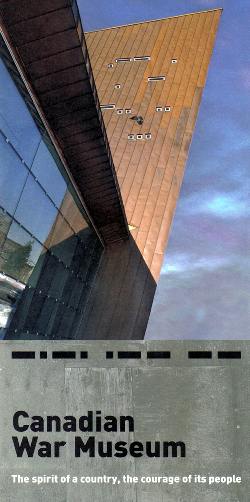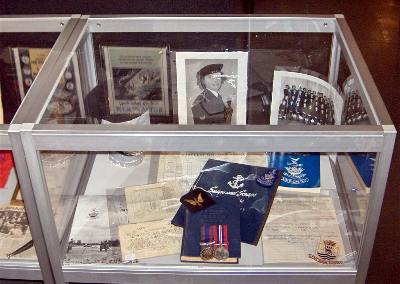 |
July 29, 2005Notes on Canada’s Year of the
Veteran
|
When Canada’s Minister of
Veterans’ Affairs announced 2005 as The Year of the Veteran he said “To-day we
ask a new generation of Canadians to surrender their time, volunteer their
hearts, and take the year to fully remember a century of sacrifice”. Sixty
years after WWII and long after many veterans are gone many initiatives are
recognizing our veterans. The new War Museum, a Veterans’ Charter and dozens of
events large and small are taking place. Native veterans, Korean War veterans
and Women veterans have been specifically recognized along with all of the other
veterans.
The New War Museum
An outstanding new War Museum
was opened on D-Day on the Lebreton Flats just west of the Parliament Buildings
in Ottawa. I had the opportunity to visit the site recently and it certainly is
a very appropriate memorial in terms of size and content. It is an architectural
masterpiece with huge spaces, beautiful light and very professional displays of
every war Canada has been involved in to the present day. There is an excellent
research centre, a boutique, an art gallery, theatre, etc. The store has a vast
array of books and other memorabilia including the John Macfie book on the
Algonquin Regiment. They did not have copies of Warpath, the story of the
Algonquin Regiment, or the remarkable new novel about 2 native snipers in WWI
(Three Day Road) and I drew this to their attention. For detailed information
on the museum see
www.warmuseum.ca or phone 1-800-555-5621 for a brochure.
 |
The new Canadian War Museum, Ottawa (submitted photo) |
If you can’t get to the new
museum there are excellent resources on line – log on to Veterans’ Affairs
Canada which lists dozens of links, or google Canadian Year of the Veteran.
Women Veterans
The Veterans Affairs website
profiles a native nurse Edith Monture from the Six Nations Reserve. Much like
Edith Parkin who was recently and belatedly recognized in Chisholm Township,
Monture trained in the U.S. and went to Base Hospital 23 in France along with
several other U.S. trained Canadian nurses. There were no Canadian military
nurses.
Chisholm’s Edith Parkin was at
Base Hospital 25. During her service she picked up a streptococcus infection
that debilitated her for years. She had a long career as a nurse in the U.S.
after the war and returned to Chisholm on retirement. The family could not
afford a headstone when she died in 1955.
As an appropriate part of the
Year of the Veteran, Edith Parkin received a headstone at Chisholm Boxwell
Cemetery on July 23. The lengthy process of establishing the Parkin Memorial
was led by former Chisholm Councillor Linda Thompson, who is active in the
Legion and the veterans’ Memory Project. M.P. Anthony Rota, who is active in
Veterans’ Affairs federally, and many others were supportive of the project.
Various family, friends, politicians and Canadian and U.S. military personnel
attended the event. Congratulations to all concerned who went the extra mile on
this important Year of the Veteran Project.
Women in WWII
Unlike WWI the second world
war had many Canadian women with 50,000 in the Armed Services with 4,500 as
Nursing Sisters. One example from North Bay that I discovered recently was the
service of Isabel (McDonald) Mauro, wife of historian Rudy Mauro.
 |
Linda Thompson checks out the Edith Parkin headstone in the
Boxwell Cemetery, Chisholm Township, prior to the unveiling. Doug Mackey
Photo. |
Isabel served for a couple of
years as a WREN working as a communications officer intercepting Japanese code
for translation to anticipate attacks. The whole operation was documented a few
years ago and many of the participants attended a reunion.
Isabel recently donated some
of her war material to the Military Communications & Electronics Museum in
Kingston. I had the pleasure of seeing her fine display there recently while
visiting this fascinating museum.
 |
The Isabel (McDonald) Mauro display at the Military
Communications & Electronics Museum, Kingston. Doug Mackey Photo |
Native Snipers
Another group being recognized
for their work as soldiers is native men who volunteered in disproportionate
numbers to their population. The Veterans’ Affairs Canada website has an
article on Native soldiers indicating that they performed remarkably well and
received over 50 medals. There is also a story about metis “Sharpshooter: Henry
Louis Norwest” who had a sniping record of 178 fatal shots before he died in
action. Native Algonquin Regiment soldier Francis Pegahmagabow from Parry Sound
Island who recently had a book written about him shot over 300 of the enemy.
Pegahmagabow was the inspiration for the book Three Day Road by Joseph Boyden
about 2 native snipers in WWI. It is doing remarkably well. The author was
recently at Gulliver’s Books in North Bay signing copies for his many fans.
Watch your local newspaper or
check the websites indicated for more Year of the Veteran events.
Heritage Perspective Home Page
| 
![]() Past
Forward is now on Facebook "LIKE" us to keep in touch
Past
Forward is now on Facebook "LIKE" us to keep in touch